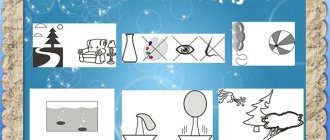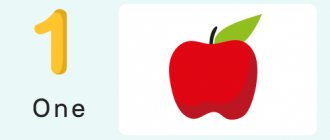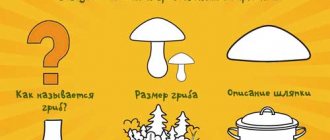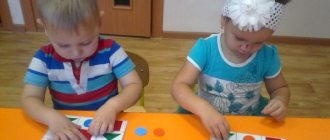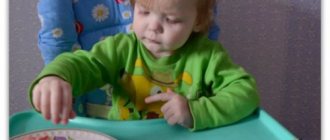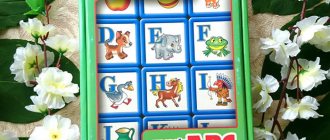Today it has become the norm that a child entering school requires much more knowledge and skills than was the case two or three decades ago. One of the important requirements for the volume of knowledge is learning letters. Nowadays, children are taught letters and sounds in preschool and various school preparation groups. However, knowledge will become more complete if preschool children constantly replenish and consolidate it in home education. Parents will be able to effectively teach their child if they use techniques for introducing children to letters, sounds, words and follow certain recommendations. What should adults know to teach a child letters?
Preschool age is the best period for learning letters
Many parents with small children have a question: when is the best time to start learning the alphabet? There are several opinions on learning letters by preschoolers:
- According to many modern parents, it is necessary to teach a child to read as soon as he speaks. They begin to master original techniques and purchase special manuals. However, there is not always enough patience and knowledge to complete the training that has begun. Therefore, the task of parents is to organize home schooling in such a way that both adults and children can do it.
- According to psychologists, there is no need to rush to teach your child the alphabet. If a child is not ready to perceive educational material, he may develop a persistent reluctance to learn letters and subsequently read. After all, this is a rather difficult task, requiring mental tension, attention, and speech. Experts believe that the optimal age for learning letters is 4–5 years, when the child is psychologically ready to learn. At this age, interest in everything new and a desire to be like an adult are more evident. Adults should take advantage of this interest and desire to learn new things.
- According to teachers (authors of early learning to read N. Zaitsev, G. Doman, V. Voskobovich), you can teach your child the alphabet much earlier than preschool age, for example, at one to two years old, if the baby shows such a desire.
The main thing that parents need to remember is that teaching should be free of coercion. Important: parents need to understand why we teach letters with a small child. If a preschooler under 4-5 years old really wants to learn the alphabet, then his desire should be encouraged. And if this is a tribute to fashion and the parents’ desire to keep up with others, then there is no need to rush. It is better to focus on general intellectual preparation and development of the speech apparatus by reading books, composing creative stories, inventing fairy tales, memorizing poems and sayings. Then preparation for school in senior preschool age will take place without stress. The preschooler himself will strive to keep up with his peers, acquire new knowledge, and actively behave in home classes to learn the alphabet.
Recommendations for getting to know the alphabet
To make learning about letters an interesting and accessible activity for preschool children and encourage them to further learn to read, parents need to get acquainted with the recommendations of specialists. This will make it possible to easily organize home classes. So, what are the principles by which we teach letters with children:
- Play, the leading activity in preschool age, should become the main method of teaching children, so the principle of homework is to learn letters by playing.
- Getting to know the alphabet is quite a difficult task for preschool children, so the work is carried out gradually, from simple to complex. There is no need to require your child to mechanically memorize the entire alphabet at once. At each lesson, you need to meaningfully practice one letter, consolidate previous material and master new ones.
- Before starting training, an adult must learn to correctly name letters: clearly and stressed consonants (b, but not “be”, m, r, s, but not “em, er, es”). The child must be taught to pronounce vowels in a drawn-out manner, for example, a - a-a.
- It is more useful to study sounds and letters at the same time to develop further syllable reading skills. This technique will help maintain interest in rather monotonous tasks. You can begin to compose syllables when the necessary supply of letters appears (ba, ma, pa, yes). It is also necessary to show that the letter being studied is necessarily included in some words, for example, a - watermelon, o - autumn, y - snail, etc.
- Experts recommend introducing letters and sounds in the order in which they are formed in ontogenesis (individual development of the body). First of all, these are the vowel sounds a, o, u, s, e and consonants. The vowels i, e, ё, yu consist of two sounds, so they are learned at an older age.
- Consolidating knowledge about letters should be accompanied by activities that are interesting for the child: drawing, modeling, appliqué, design. For this purpose, experts have developed many games and exercises that can be used in preparation for homework.
Notes on teaching literacy in the senior group “Introduction to the alphabet”
Brief description of the document:
Notes on teaching literacy in the senior group “Acquaintance with the alphabet” Objectives: introduce the alphabet; develop the ability to read words with familiar letters; practice writing letters in print in a notebook. Equipment: plastic letters on magnets, cards with words and letters, workbook, pen. Contents of organized educational activities 1. Organizational moment. Invented by someone Simple and wise, Say hello when you meet! - Good morning! - Good morning to the Sun and the birds! - Good morning! Friendly faces! And everyone becomes kind and trusting! Good morning lasts until evening. The one whose name begins with the letter A will sit down, now the one whose name begins with the letter D, O, M, P, S, F, S, L will sit down. 2. Main part Methodological techniques A story about the emergence of the alphabet. The Russian alphabet was created by the monks Cyril and Methodius. Who are monks? They knew the Greek and Latin alphabets very well, so many letters of the Russian alphabet are similar to the letters of these alphabets. And they first named it in honor of the monk Cyril - “Cyrillic”. The modern Russian alphabet comes from the Cyrillic alphabet. The word “ABC” exists only in the Russian language, and it comes from the first letters of the Cyrillic alphabet – “AZ” and “BUKI” - AZBUKA are letters only in the Russian language, arranged strictly in order. There are many different alphabets in the world: Latin, German, French, English... An alphabet is the letters of a language, arranged strictly in order. Most alphabets come from ancient picture writing. People drew pictures and conveyed what they wanted to talk about. Getting to know the alphabet and memorizing it. The modern Russian alphabet consists of 33 letters, which are in strict order: Listen to the poem and try to remember in what order the letters are: ABC song (B. Zakhoder) Thirty-three sisters, Written beauties, Live on one page, And are famous everywhere ! They are rushing to you now, Glorious sisters, - We really ask all the guys to make friends with them! A, B, C, D, D, F, F They rolled up on the hedgehog! Z, I, K, L, M, N, O Climbed out the window together! P, R, S, T, U, F, X They saddled the rooster, - C, Ch, Sh, Shch, E, Yu, I - Here they are, friends!.. Meet them, children! Here they are, standing side by side, It’s very bad to live in the world for those who don’t know them! Try to repeat the letters of the alphabet with the help of this poem (3 - 4 children). Look carefully at this picture and tell me which letters the author of the poem forgot about (E, J, Y, b, b). Now I know that you have memorized all the letters of the alphabet. Now I’ll check how well you know all the sounds and letters. Let’s just rest and do the exercise first. Physical education A, Be, Ve, Ge, De, E, Yo, (walking in place) Know your place! Zhe, Ze, I, Y, Ka, eL, em, (jumping on the right leg) Remember who is behind whom! eN, O, Pe, eR, eS, Te, U, (jumping on the left leg) Stand together, all in a row! eF, Ha, Tse, Che, Sha and Shcha, (turns to the sides) Place yourself slowly! Hard sign and soft sign, (squats) Stand side by side, like this! Hurry up E, Yu, Ya! (walking in place) The whole family is here! Game “Guess the Word” The first letter of this word is in the alphabet after the letter B, the second is behind the letter N, the third is behind K, the last is behind the letter Y. (Wolf) The first letter of this word is in the alphabet before the letter L, the second is before letter P, third before T, fourth before B. (Spit) Game “Letters around me” Ask the child to look around the room and name all the objects that surround him, but only in alphabetical order. For example: A - watermelon, B - jar, C - hanger, D - curtains. Reading words and small sentences. Finger gymnastics I am a cheerful person, I walk and sing. I am a cheerful person, I really like to play. I’ll rub my palms hard, I’ll twirl each finger, I’ll say hello to him strongly, and I’ll start stretching. Then I’ll wash my hands, fold them finger by finger, lock them and keep them warm. Typing words under dictation from the teacher in a workbook. 3. Final part 1. Summing up the topic. General questions on the topic. What did you do in class? What tasks did you perform? What new did you learn? 2. Reflection. Did you like the lesson? What did you like about the lesson? What difficulties arose during the lesson?
Games and exercises for home activities
How to teach your child letters at home? In addition to special aids, such as a primer, the alphabet, in psychological and pedagogical practice you can find many interesting tasks for consolidating knowledge about letters and sounds. Such collections will help parents organize home schooling competently and, most importantly, in an interesting way. There is no need to take on complex gaming tasks; the simplest games can become a fun learning tool for kids.
We are building an unusual house
A simple game exercise with cubes will help reinforce the names of the letters. An adult can purchase ready-made cubes with images of letters; together with your child, you can prepare homemade ones, for example, by painting ordinary wooden cubes. With their help we learn letters, for example:
- Let's build a ladder of letters that can sing (vowel sounds a, o, u, s, e);
- Let's build a house for the doll from cubes with different letters and teach them to call them d, o, m;
- Let's show the correct cube - the answer, for example, to riddles with the letter b:
I walk around in a fluffy fur coat, I live in a dense forest. In a hollow on an old oak tree I gnaw nuts (squirrel)
There are workers in the river, neither joiners nor carpenters, but they will build a dam - at least paint a picture (beavers)
- Let's find a cube where a stork is drawn (ask what the first letter is).
Parents' creativity can help make playing with blocks fun. Cubes with a certain letter can be placed everywhere: in the room, kitchen, hallway; on the closet, TV, table, windowsill, so that they constantly accompany the baby.
Where is the letter hidden?
An adult places one copy of the letters in different places in the room, and hangs the other in a visible place for comparison. Among them is a letter that the child needs to find. The game is played according to the “hot - cold” type. The player follows the adult’s instructions, for example: go straight, then turn left, take two steps, turn left again. The leader directs the movement using the words “cold, warmer, cold again, warm, hot.” On the way, the baby finds other letters and compares them with the one he is looking for. In addition to consolidating letters, spatial skills are developed.
Who can collect the letters faster?
It is advisable for several participants to play, so it is good if the whole family takes part in the game. Pictures with different images of the same letter are laid out on the court, and the players, at the leader’s signal, begin to collect them. It’s good to use funny rhymes, you can write your own, to create a positive mood, for example: “An arrow leads us to the letter b. Here is a birch tree, and here is a squirrel.” The one who collects the most images faster wins. There must be a student among the winners.
Bag with letters
We study letters with the children using the classic version of the “wonderful bag”. An adult prepares a beautiful bag, puts small objects in it, the name of which begins with the letter being studied, for example, “r”: pen, fish, strap, comb, daisy, robot. The child takes out the object and clearly pronounces the word. In the future, the game becomes more complicated because the letter being studied moves to the middle and end of the word.
What does the letter look like?
The game is played according to the type of associations (images that arise in the mind in response to a letter). Such tasks help children easily remember letters, without repeating them many times. Associations can be something like this: come up with an object that the letter looks like ( A is like the roof of a house, O is a steering wheel, a wheel, U is a twig fell from a tree, F is a bug, P is a collar). In this exercise it will be interesting to use rhymes that can be found in any textbook for preschoolers, for example:
B is like a trumpet that buzzes: “Boo-boo, boo-boo”!
Looks like B , no doubt, like pretzels, a bicycle.
the letter D , it’s sailing towards us like a boat.
The letter Z is just like a beetle, perched on a branch.
Educational online games
In addition to classical games and exercises, online games are actively used as one of the techniques in modern pedagogy. They can be successfully introduced into home activities. The main thing is to remember that the time spent at the computer should be limited for preschoolers to 10 to 15 minutes. Games must also correspond to the age of the children, level of knowledge and methodological requirements, for example, for children online - the game teaches them to correctly name letters, for older preschoolers - to remember the order of letters, form syllables, and look for missing letters in words. We learn letters with children using, for example, such games:
Talking alphabet for children
The talking alphabet works wonders! Press any letter and immediately get the word! In the game, the preschooler fixes the correct name of the letter and sees a picture that depicts an object for this letter. It is useful to practice this task for those children who are just beginning to recognize letters. You can make the game more difficult for older preschoolers by asking them to remember their order in the alphabet.
Connect the dots
Games like connecting dots with one line are intended for older preschoolers; they help remember the order of letters and distinguish between vowels and consonants. For example, one of these online games is “Little Foxes,” in which, using the correct combination of letters, a funny picture is created. The player, by pressing the keyboard buttons and connecting the dots, remembers the letters. If the task is completed correctly, the winter forest will be covered with snow. A more complex option: the preschooler is explained that vowel letters (singing) are colored red, consonants are colored blue (hard), and green (soft). The child must pronounce them with correct articulation.
Lesson notes on the Russian language, 1st grade. Russian alphabet, or ABC. School of Russia
Russian language lesson for 1st grade on the topic “Russian alphabet, or ABC”
Objectives: to introduce the Russian alphabet and explain its meaning; develop the ability to use the alphabet. Planned results : students will learn to correctly name letters in alphabetical order.
Lesson progress
I. Organizational moment II. Updating knowledge Test (The teacher can use tasks from manuals (see KIM, test 5 on pp. 22-25; TT, test 3 on pp. 21-27; PKR, tasks nas. 33-36).) III. Self-determination for activity - Guess the riddle. On the page of the ABC book Thirty-three heroes. Every literate person knows the sages-heroes. (Alphabet.) - Guess what will be discussed in class today. (About the alphabet.) IV. Work on the topic of the lesson 1. Introduction to the alphabet (Before the lesson, the teacher distributes spelling dictionaries to the students.) - Guess the riddle.
The living castle grumbled and lay across the door. (Dog.) - What can you say about this word? (This is a word from the dictionary.) - Find this word in the spelling dictionary that is on your desk. What page is it on? — Was it easy for you to find him? — Could this task be completed faster? What do you need to know for this? (You need to know the alphabet.) (The teacher hangs a poster with the alphabet on the board.) All words in the dictionaries are arranged in alphabetical order. (You can show other dictionaries.) - Where else is the alphabet used? (Books in the library and student forms are arranged in alphabetical order, the list of students in the magazine is compiled in alphabetical order, in the hospital patient cards are in alphabetical order, etc.) - So what is the alphabet? (Letters arranged in a certain order.) - Has he always been the way you see him now? (Children's answers.) Material for teachers
The historian Herodotus wrote that the ancient Greeks learned writing from the Phoenicians.
Indeed, even the names of the Greek letters themselves are Phoenician words. For example, the name of the letter “alpha” (A) comes from the Phoenician word aleph - bull (the original shape of this letter resembled the head of a bull). The name of the Greek letter "beta" comes from the Phoenician word bet - house (originally this letter was a simplified drawing of the plan of a house). The word alphabet itself is essentially a combination of the Phoenician words aleph and bet. The letters in the Phoenician alphabet were arranged in a certain order. This order was also adopted by the Greeks. The Phoenician alphabet was the ancestor of not only Greek, but also Arabic, Hebrew and other alphabets. It is more convenient than any hieroglyphs. But the Greek alphabet is even more perfect. In it, the signs no longer indicated syllables, but letters. It formed the basis of the Latin alphabet, and that, in turn, formed the basis of all Western European ones. The Church Slavonic alphabet, compiled by the brothers Cyril and Methodius, came from the Greek alphabet - the Cyrillic alphabet. Under Peter I, the Church Slavonic alphabet was simplified, and an easier-to-read civil version appeared, which is still used in Russia with minor changes. 2. Work according to the textbook Ex.
1 (p. 52) - Read. — How many letters are in the Russian alphabet? (33.) - Read the names of these letters and try to remember. — To make it easier to remember the alphabet, we will sing it. Do you remember the song about the grasshopper? There was a grasshopper sitting in the grass (twice), just like a little green cucumber. It is to this tune that we will sing the names of the letters. (Write on the board.)
— The song needs to be sung line by line.
Pause at the end of each line. There is no need to pronounce the word sign. — Put dashes in your textbooks with a pencil in the places where we pause. You will need to learn the alphabet at home. — Read information about the language. - What is the alphabet? Ex.
2 (p. 53) - Read.
- Name the letters of the alphabet. —What are letters needed for? — How many letters are there in the alphabet? - Find letters in the alphabet that do not represent sounds. Ex.
3 (p. 53) - Read the sentence.
What sign is at the end of the sentence? - Read it expressively. — Explain why you need to be able to read well. 3. Vocabulary work (The teacher can use the manual (see OS, p. 65).) - Find the “hidden” word. VRPYADHOROSHOACHI - Write the word good
in your notebook.
Place stress and emphasize unstressed vowels. Remember the combination -ORO- in this word. - Come up with a sentence with this word. 4. Work according to the textbook - Read on p. 53 about the origin of the words alphabet and alphabet. -Where did these words come to us? V. Physical education minute Pinocchio stretched, Once - bent over, Two - bent over, spread his arms to the sides. Apparently I didn't find the key. To get the key, we need to stand on our toes. VI. Consolidation of the studied material 1. Work from the textbook Ex.
4 (p. 54) - Read.
-What did you notice? —Are all the letters of the alphabet written down? — Which letters are out of place? - Complete the task. Ex.
5 (p. 54) - Look at the pictures.
- Name the letters correctly. - Why do you think they are located on different balloons? (The letters are grouped depending on how their names are pronounced.) - Read the last task. Do it yourself. Ex.
6 (p. 55) - Read.
—Are all the letters named correctly? Who made a mistake? - Name these letters correctly. - Read the last task. Do it yourself. 2. Game “Find your place” (Students receive letters from a split alphabet. At the teacher’s command, they must stand in alphabetical order.) 3. Completing tasks in the workbook Ex.
1 (p. 26) (Independent completion of the task.) - Read the alphabet.
Ex.
2 (p. 26) - Read.
Complete the task. - Read the sentence you wrote down. Ex.
3 (p. 27) - Look at the drawing.
Complete the task. - Read it. (Welcome to forest school!) Ex.
4 (p. 27) - Read the riddles.
Complete the task. - What letters did you write? (Sh, p.) (The teacher can use tasks from manuals (see RT, tasks 1-3 nas. 22, 23; SU, tasks nas. 25; Tr., tasks nas. 23, 24).) VII . Reflection - What is the alphabet? — How many letters are in the Russian alphabet? - Who has already memorized the alphabet? - Who else needs a little training? - Evaluate your work in class. VIII. Lesson summary - What new did you learn during the lesson?
We recommend watching:
Lesson notes on the Russian language, 1st grade. School of Russia. Language and speech. Their significance in people's lives Lesson notes on the Russian language, 1st grade. Offer. School of Russia Lesson notes on the Russian language, 1st grade. Dialogue. Kanakina. School of Russia Lesson notes on the Russian language, 1st grade. School of Russia. Sounds and letters, 1 lesson
Similar articles:
Lesson notes on the Russian language, 1st grade. Consonant sounds. School of Russia
Lesson notes on the Russian language, 1st grade. Hard and soft consonants
Lesson notes on the Russian language, 1st grade. Spelling letters denoting paired consonant sounds at the end of words
Lesson notes on the Russian language, 1st grade. Letter combinations CHK, CHN, CHT. School of Russia
Lesson notes on the Russian language, 1st grade. Capital letter in words. School of Russia
How to teach your child the alphabet using creativity
Parents will be interested to know that in addition to the classic methods of learning about letters, there are other exciting methods that will interest both adults and children. They are based on creative activities, which always attract preschool children: appliqué, drawing, modeling, design.
Application
An adult and a child cut out letters from thick paper of a fairly large size. Then comes the preparation of decorations, this can be cereals, fabric, colored paper, beads. Decorations are applied to stencils using glue. The result is bright, beautiful letters that can be assembled into a garland and placed in different places (children's corner, wall, on the Christmas tree).
Drawing
Drawing letters is an original technique for memorizing them. You can draw on paper with felt-tip pens, on a board and asphalt with crayons, or with a stick on the sand. For the same purpose, you can use all kinds of coloring books, old magazines, in which you can search with your preschooler and trace familiar letters with a felt-tip pen.
Modeling
Letters will be remembered faster if you hold them in your hands and manipulate them, that is, sculpt them. At the same time, it is a good tool for the development of fine motor skills directly related to speech. Plasticine, clay, and salt dough are suitable for this purpose. Just like in applique, finished letters can be decorated with polka dots, beads, or simply painted with gouache paints.
Construction
Building letters is a fun activity for kids! It helps not only to consolidate the alphabet, but also develops hand motor skills, thinking, attention, and the desire for associations (seeing letters in surrounding objects). You can build or design letters not only from a special construction set (metal, wood, plastic), but also from any available material material. For example, from sticks, matchboxes, little hardcover books. Everything your imagination is rich in can become material for constructing letters.
Dear parents! In modern pedagogy there are many original methods with which you can quickly learn letters and move on to reading. Every parent can teach their child letters. However, every parent must remember that learning should bring joy to the child, a living desire to learn new things, and not be a tedious, monotonous task. Your meaningful decision, patience, and love for your child will help you achieve good results. Good luck with raising your children!
